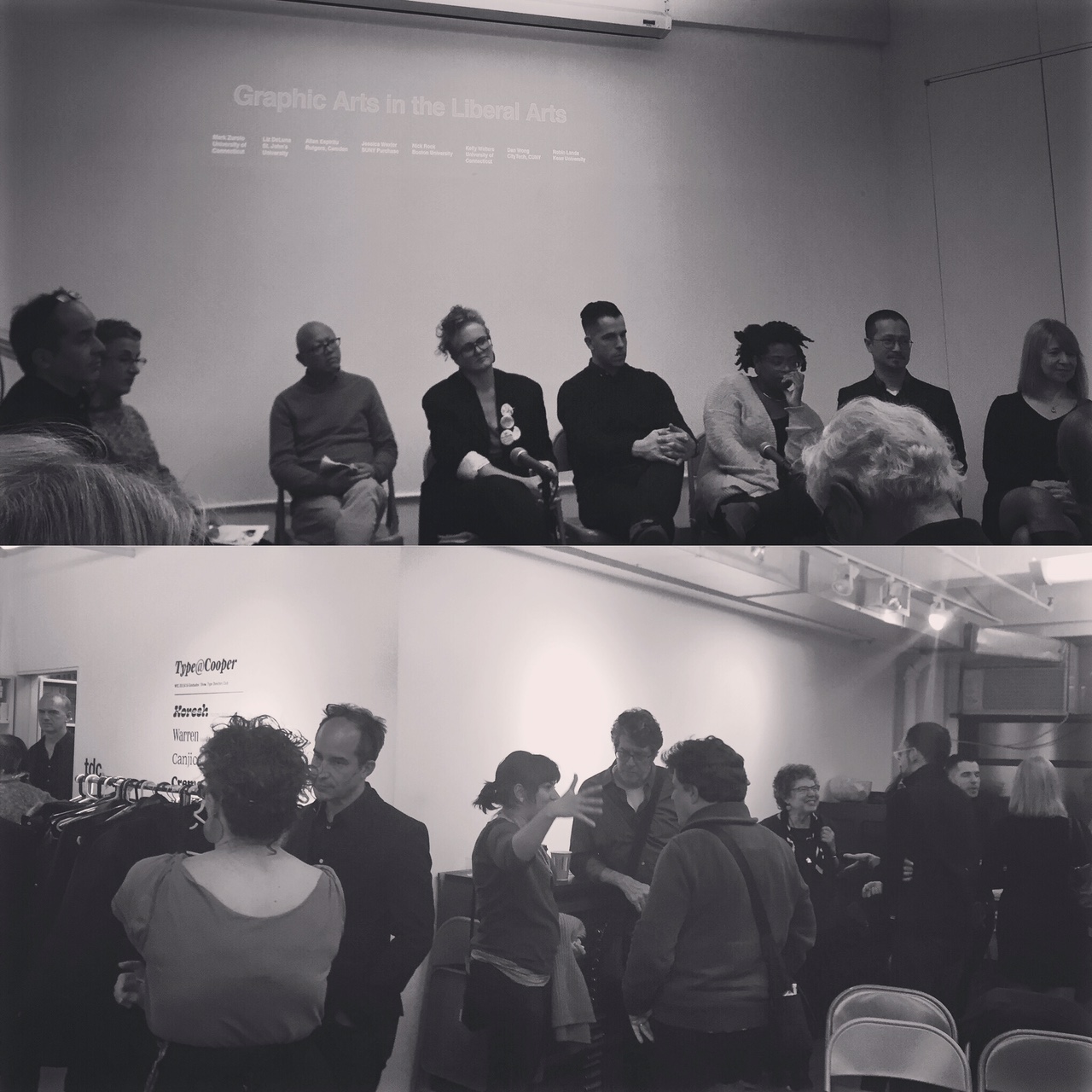
Feb
Recap | Graphic Arts in the Liberal Arts
[responsivevoice_button voice=”UK English Female” buttontext=”Listen to Post”]
In November 2016 IDSL attended Graphic Arts in the Liberal Arts, a panel discussion co-hosted by The Type Directors Club and Design Incubation, which supports design educators, peer feedback on proposed projects. There was a fairly diverse panel, not only in terms of race and age, but in discipline, size of school and student demographics served. But I think I was the only other black woman in the room. Moderators excellently started with focusing on the conversation, instead of Trump stuff from the Presidential election result. For the purposes of this recap keep in mind that responses will be fragmented, and often taken out of full context.
”It's not my job to teach my students to be risk-takers, but we can engage with them. Figure why they're so frustrated.
Big Takeaway Questions and Responses
Q: What are the advantages of teaching in a liberal arts institution?
A: The cross-disciplinary, mash-up classes where you teach w/another professor. Like w/ an English teacher, given a limit of 48 credits for an entire design program.
A: Political disputes make the needs of the schools different. Form-making does not teach critical thinking. Liberal arts teaches critical thinking skills.
A: They get to go to the business school, engineering school (this was not the case when I was at Howard, ten years ago. Not sure if that’s changed.)
A: The projects are richer. A disadvantage to not be immersed in the arts all the time.
A: CityTech went from two-year to four-year in the late ’90s. Modeled after design and BFA programs. Includes classes like nursing and hospitality.
A: A human rights institute within a university system that gives you a rich experience. Have read world literature, sociology, and anthropology.
A: Force students to break down visual language for students who don’t operate in a visual language.
”Teaching grid design is more important than teaching them grid design in InDesign.
Q: What is more important: A fluency demand (software) vs. critical thinking?
A: You have to know how a book gets made, to even know what a book is. Hand skills are still important. All those things are historically still relevant. Make them learn things on their own. I’ll teach you the basics…
A: How to you know that they’re using the tool appropriately? Are there grid systems, production techniques? They need to figure it out, but they still need guidance.
A: When you think about how much is consumed digitally, should we be really focusing on book binding? I question whether not teaching software is okay.
A: Using the program is treated as a suggestion. Students share their own learning. The tools change constantly. Teaching grid design is more important than teaching them grid design in InDesign.
A: The question is how to teachers open up space for learning. We’re not going to keep up. That is okay. It’s a problem of resources. It assumes that instructors and deans have a shared interest. They do not.
Q: How fluid should curriculum be?
A: Instead of being in silos, students can pick from pots. Videography or Strategy and design thinking. Students can create their own major.
A: Working backwards, finding out from the industry what students need to know when they join the workforce.
A: You’re thinking about content, you’re thinking about voice; much broader topics. They need to be learning code, AfterEffects for animation.
A: 3D printing class in Physics or book building in English “You have to take that class.” Gets to pick an adjunct.
A: I teach craft as a way of learning how to learn.
A: Language barriers, diversity, and culture. Segregate into their own populations, or it’s difficult for faculty.
A: UConn: Teaching culture through digital quilts.
A: CityTech: Open enrollment program, must pass remedial, aiming to get them to the same point as all the other programs.
A: It’s okay to be random and bizarre in addition to showing the skills you need to succeed.
”A human rights institute within a university system that gives you a rich experience.
Does over-testing make an art or design student incapable of creativity?
A question from the audience sparked considerable discussion, and that was the issue concerning students who were coming into design programs that has been over-tested and anxious to make the “right” answer. These were a few responses:
A: It’s not my job to teach my students to be risk-takers, but we can engage with them. Figure why they’re so frustrated. I stop asking them to be active participants. I can not have a project that is open-ended. I have to do a lot of scaffolding.
A: Phasing in the results, helps alleviate student’s anxiety.
A: There are multiple ways of doing it right.
Should designers be writers?
Another concern that was brought up by design educators in the audience was the need for students to become better writers. Ostensibly for copywriting, presentations, and creative briefs. But in terms of writing just to write I said that in all honesty most people don’t care what designers think. So if you want to write, it has to be self-generating, and you have to ask yourself what do you have to offer in your words that no one else can. I got the impression from panelist’s responses that design educators are more satisfied if their students go on to make political posters that spark debate, rather that write about the politics of design. I found that frankly disappointing.
The constant tension between the purpose of a collage education is not exclusive to graphic arts. Is it to make students better people or to get them a job? It was an excellent opportunity to think about it among a thoughtful audience.


